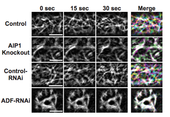Highlight
Actin Interacting Protein 1 and Actin Depolymerizing Factor Drive Rapid Actin Dynamics in Polarized Plant Cells
Achievement/Results
Led by Robert Augustine (IGERT trainee), the Bezanilla (IGERT advisor) laboratory at the University of Massachusetts Amherst demonstrated that actin interacting protein 1 (AIP1) and actin depolymerizing factor (ADF) are critical for promoting cortical actin dynamics in plant cells. The rapid remodeling of actin filaments in plants is required for polarized growth of agriculturally important cell types including root hairs and pollen tubes. These cells are critical for sexual reproduction and overall plant fitness in flowering plants, which comprise the majority of our crop species. Therefore, it is essential to identify genes that promote polarized growth. Image analysis algorithms were integrated with cell and molecular biology approaches to identify AIP1 and ADF as critical mediators of polarized growth. By developing algorithms that analyze actin filament movements over time, these genes were shown to be essential for promoting actin dynamics. These findings are currently in submission to The Plant Cell.
Until now, the genes involved in promoting actin remodeling have been difficult to identify due to the presence of multiple gene copies that act redundantly and complicate the analysis of function. Using the moss Physcomitrella patens, a single ADF and AIP1 were identified, simplifying functional analysis. Genetic tools available in moss permitted the removal of AIP1 and ADF gene function and this resulted in a dramatic polarized growth defect. Furthermore, results demonstrate that AIP1 and ADF cooperate in the cell to promote polarized cell growth in plants.
To understand the mechanism by which AIP1 and ADF function in polarized cell expansion, the extent to which these proteins affect actin dynamics was investigated. Actin-binding proteins such as AIP1 and ADF have been widely regarded as promoters of actin dynamics due to their ability to turnover actin filaments in biochemical assays. However, few studies have directly tested this in live cells. A major limitation to this has been the inability to quantify actin dynamics. To overcome this obstacle, the Bezanilla laboratory, in collaboration with a physicist and cell biologist at Worcester Polytechnic Institute, imaged cortical actin filaments in control, ADF- and AIP1- loss-of-function plants (Figure 1) and developed an algorithm to quantify actin filament behavior over time. Using this analysis, it was demonstrated that AIP1 enhances and ADF is absolutely critical for generating dynamic actin filament networks at the cortex of plant cells (Figure 2). This study provides a genetic basis for the dynamic remodeling of cortical actin network in plants and reinforces the notion that a balance between assembly and disassembly of actin filaments is required for the construction of actin filament arrays that are required for promoting polarized plant cell growth.
Address Goals
By elucidating the fundamental molecular mechanisms controlling plant cell tip growth, this research will impact the understanding of two critically important plant cell types, the pollen tube and root hairs, both of which are involved in determining overall plant fitness. In an effort to meet future energy demands using renewable energy sources, much attention has shifted to plant-derived biofuels. However, a major obstacle for this technology is the acquisition of enough biomass from available land to meet these demands. This research will help to elucidate fundamental mechanisms of cell growth that impact future production of plant biomass.
Genetically-modified crops show much potential for improving yields and nutritional value, reducing pesticide use, and enhancing resistance to environmental stresses. However a major source of controversy exists in the public fear that genes from transgenic crops will cross into the native species. Here, ADF and AIP1 have been identified as genes whose loss of function potently inhibits tip growth. Specific loss of function of these genes in the pollen grains will serve as a good candidate for preventing pollen development and transmission of transgenic traits via cross pollination. The development of analysis methods for quantifying actin dynamics will be of use to the entire scientific community. This analysis will be of vital importance for assaying whether genes are important and to what extent they are important for regulating actin dynamics. More broadly, this analysis should also be useful for analyzing dynamics of other filamentous networks such as the microtubule cytoskeleton.







